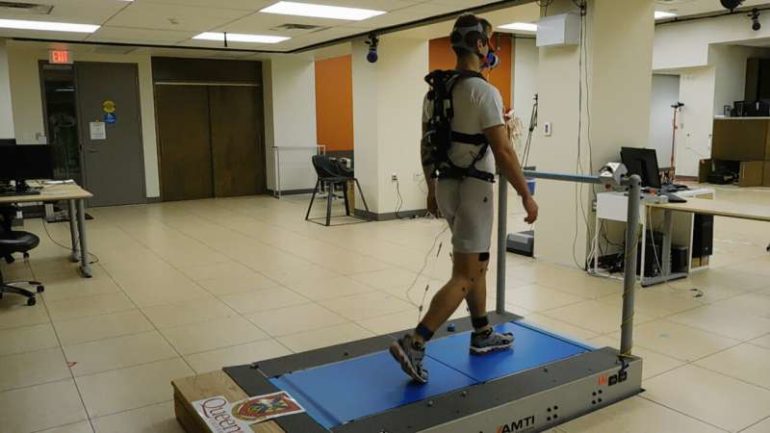A team of researchers at Queen’s University in Canada has developed an exoskeleton that reduces the metabolic cost of walking. In their paper published in the journal Science, the group describes their system and how it works. Raziel Riemer, Richard Nuckols and Gregory Sawicki with the Ben-Gurion University of the Negev, Harvard University and the University of Georgia, respectively, have published a Perspectives piece in the same journal issue outlining the work by the team.
Prior research has shown that there is a metabolic cost to walking. Energy is expended in a variety of ways by parts of the feet, legs, pelvis and torso. Prior research has also shown that during each step, the leg lifted into the air must apply a braking force as it moves to land to keep the person from tumbling forward. Riemer, Nuckols and Sawicki note that braking is relatively expensive for muscles, as they have to tense and maintain a braking force while also stretching slightly. Braking for mechanical systems, on the other hand, is cheap. In this new effort, the researchers took advantage of this difference by designing an exoskeleton that takes over some of the braking that occurs during walking and thereby reduces the overall metabolic cost of walking.
In designing their system, the researchers also wanted to capture some of the energy that is lost during walking, so they added a small generator. The generator has cables that attach to the legs and tighten as a leg moves into a braking position. Resistance from the generator then provides a slight braking force, relieving the leg from having to do all the work. Thus, not only does the exoskeleton reduce the metabolic cost of walking, it also produces a small amount of electricity.
Testing showed the exoskeleton gives walkers a 3.3% net metabolic benefit—enough, the researchers claim, to be noticeable by someone walking a long distance. They acknowledge that the weight of the generator, which is carried on the back, reduced the benefit by 1%—but it also resulted in producing 0.25 W of generated electricity per gait cycle.
Ankle exoskeleton enables faster walking
More information:
Raziel Riemer et al, Extracting electricity with exosuit braking, Science (2021). DOI: 10.1126/science.abh4007
Michael Shepertycky et al, Removing energy with an exoskeleton reduces the metabolic cost of walking, Science (2021). DOI: 10.1126/science.aba9947
2021 Science X Network
Citation:
Exoskeleton reduces amount of work required to walk (2021, May 28)
retrieved 31 May 2021
from https://medicalxpress.com/news/2021-05-exoskeleton-amount-required.html
This document is subject to copyright. Apart from any fair dealing for the purpose of private study or research, no
part may be reproduced without the written permission. The content is provided for information purposes only.
